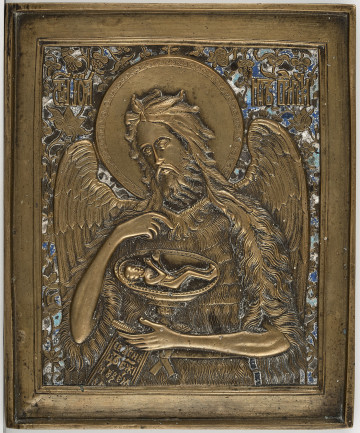
St. John the Baptist
20th century
Castle Museum in Łańcut
Part of the collection: Icons
Icon, Christ Pantocrator. The Old Testament prohibition against making an image of Yahweh lost its significance with the coming of the Son of God. The making of his image is justified in the New Testament, where Christ is called consubstantial with the Father, the Word Incarnate, the image of the Invisible God (Jn. 14:9–10; Col. 1:15). Therefore, according to the conciliar canons, in the art of the Eastern Church, God was depicted only in the person of Christ. Some of the oldest representations of the Saviour were images showing the Omnipotence and Divine Nature of Christ called the Lord of All, Pantocrator in Greek. Christ began to be depicted as Ruler of the Universe, modelled on the image of an earthly ruler, with all the marks of imperial dignity, in the 4th to 6th centuries. The figure of the Saviour, always frontally depicted, was placed in the dome of the temple symbolising heaven. Over time, the image of the Pantocrator took centre stage in Deesis representations with the figures of the Mother of God and John the Baptist adoring the enthroned Saviour and offering intercessory prayers to him for mankind. The image of Christ also appears in the sovereign row of the altar partition. There are three variants of the Pantocrator image. He is shown standing in full form, seated on a throne, and in later iconography, he is more often depicted in bust. The fingers of the right hand raised to breast height are usually arranged in the shape of a monogram of Christ’s name IC XC. The arrangement of the fingers can be read simultaneously as a symbol of the Saviour’s dual divine-human nature and of the Trinity. In later representations, known in Western Christianity as Salvator Mundi or Ruler of the World, Christ holds in his left hand a sphere topped with a cross as a sign of world dominion, as in the presented household icon decorated with a metal cover repeating the outline of the painted figure. Teresa Bagińska-Żurawska https://orcid.org/0000-0002-9243-3967
Other names
Salvator Mundi
Author / creator
Dimensions
height: 17.5 cm, width: 13.5 cm
Object type
Icons
Technique
tempera, gilding paint, metalloplastics
Material
silver, brass, tempera, wood
Origin / acquisition method
decyzja administracyjna
Creation time / dating
Creation / finding place
Owner
Castle Museum in Łańcut
Identification number
Location / status

20th century
Castle Museum in Łańcut

19th (?) century
Castle Museum in Łańcut

1800 — 1850
Castle Museum in Łańcut
DISCOVER this TOPIC
National Museum in Lublin
DISCOVER this PATH
Educational path